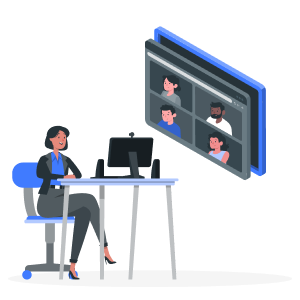
Remote Exam Monitoring: Ensuring the Integrity of Online Assessments #
Remote exam monitoring is a method of monitoring students while they are taking an exam remotely, using technology such as a webcam and microphone. The purpose of remote exam monitoring is to ensure the integrity and security of the exam by making sure that students are following the rules and not cheating. During the exam, a proctor or invigilator may be watching the students through the webcam and listen to them through the microphone to make sure that they are following the rules. Remote exam monitoring can be used in a variety of settings, including online education and professional certification exams.
There are several key features that a good remote exam monitoring system should have: #
Video recording: The system should be able to record the student’s face and surroundings using a webcam. This allows the proctor to see what the student is doing during the exam.
Audio recording: In addition to recording video, the system should also be able to record audio. This can be helpful for detecting any suspicious noises or conversations that may occur during the exam. Although audio proctoring is a separate mechanism for proctoring, it can be integrated with video proctoring for attaining better accuracy.
Live to monitor: The proctor should be able to monitor the student’s webcam feed in real-time, so they can identify any suspicious behavior as it occurs. Live monitoring can be done by a human or by AI.
Artificial intelligence: The system should use artificial intelligence (AI) to automatically detect suspicious behaviors, such as the student looking away from the screen or using unauthorized materials. This phenomenon of taking the help of AI in proctoring is called “AI proctoring”.
Human review: If AI flags any suspicious behavior, the system should allow a human proctor to review the footage and make a determination about whether the behavior was inappropriate.
FAQs #
1) How does remote exam monitoring work? #
Remote exam monitoring involves using a webcam to record a student’s face and surroundings while they take an online exam. The video is then reviewed by artificial intelligence or a human proctor to ensure that the student is following the rules and not cheating. This promotes adherence to exam rules and makes online exams reliable.
2) Is remote exam monitoring accurate? #
Remote exam monitoring can be considered one of the best ways of cheating prevention, just like a pen and paper-based examination, the invigilator can keep watch on the students, further integration of this with audio proctoring and AI can greatly help in attaining 100% malpractice free examination.
3) What are the prerequisites for appearing in a remote exam monitored online exam? #
The specific prerequisites for appearing in a remote exam monitored examination will depend on the policies of the institution or organization administering the exam. Here are some common prerequisites that students may be required to meet:
Technical requirements: Students may be required to have certain technical requirements in place, such as a webcam, microphone, and a stable internet connection.
Testing environment: Students may be required to take the exam in a quiet, well-lit location where they can be clearly seen and heard by the proctor.
Identification: Students may be required to provide identification, such as a driver’s license, aadhar, college ID card, or passport, to verify their identity.
Testing agreement: Students may be required to sign a testing agreement stating that they will follow the rules of the exam and will not engage in any inappropriate behavior.
Familiarization with the system: Students may be required to familiarize themselves with the remote exam monitoring system before the exam, to ensure that they know how to use it properly.


